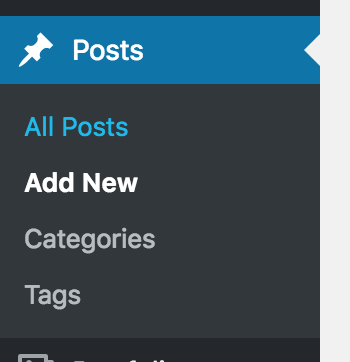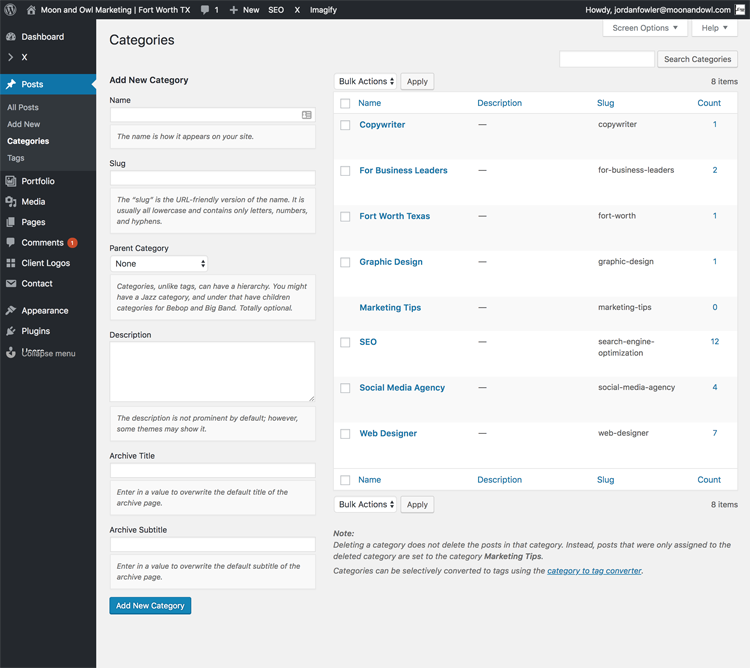Unfortunately, site after site we see has blog categories not optimized for search engine results. You can change your haphazard blog categories easily and get better SEO results!
When you or your web designer originally set up your blog, probably little was done regarding deciding on what categories to use.
Over time, as you published an article and a new category sounded nice, you probably just added it.
If an article fits into two different categories, you happily check off both categories.
This is how to make sure your site doesn’t get ranked as well.
When Google, Bing, Yahoo and other search engines look at your site, there is no cohesive site skeleton with this approach. The search engines see random categories and the dual categories cause the category silo to bleed into each other, further reducing your rankings.
Remember this rule of thumb; categories are like your website’s table of contents and tags are like an index. Use categories sparingly and tags judiciously.
How To Set Up Your Blog Categories and Service or Product Pages
Ideally, you create a page, not a post, for each service or product grouping you offer.
For example, on this site you’ll notice we have pages for:
- Web Design
- SEO
- Social Media Marketing
- Copywriting
- Graphic Design
- Traditional Marketing
Each of those pages has at least 1,000 words on it.
We decided what to call each page based on the search volume of keywords and the user’s perceived intention.
Keyword Search Volume
How do we decide this? We load a ton of related keywords into ranktrackr.com and see which words have the highest monthly search volume but lower competitive results. This winning term is the low hanging fruit and can rank well. This term is what we title the page.
User Intent
You also want to get inside the searchers head and think what term would they use if they are seeking your services, products, or content.
Our web design page is actually called web designer, not web design because web designer is the term people search when they want to hire one. When they search web design it could be for a myriad of alternative reasons (to see cool sites, to DIY their site, to search newest trends, etc.)
Armed with these two pieces of information you can now create properly titled and structured main service or product landing pages.
Matching Your Blog Categories to Your Service or Product Pages
Now it’s time to EXACT MATCH your blog categories to your service pages.
Continuing with our example, our blog category for web design and development is called web designer, exactly matching the service page title.
Even the URL slugs match: moonandowl.com/webdesigner (page) and moonandowl.com/webdesigner (blog category).
Why do we do this? This is done so that all the SEO juice from the articles we write passes up to the main service landing page. This page is what we actually want to rank as the head of the silo.
With our special SEO plugin (which by the way crushes Yoast and All-in-One-SEO), we can have the category URL be canonically relevant to the main page. That means that the blog category for web designer actually passes all the SEO juice through the URL structure to the main web designer landing page. This is called hard siloing, where the URL link structures on your site carry forward the desired site skeleton.
Once you write a blog article, it’s important that you only select one category for it. Even if it can fall into two categories, pick a single one for this particular post.
Somewhere within the post itself, take the main keyword for that post and hyperlink it up to the landing page. This is called virtual or soft siloing. (BTW, if you have not clue how to even start out blog check out this post by a friend on how to start a blog.)
If you link from an article in one silo to an article in a different silo, make sure to make that a no-follow link. Remember, we want our silos to be 100% clean and not bleed into other silos. This confuses the search engines. (You’ll notice we didn’t hyperlink all those services in bullet points above because this our SEO silo and we don’t want it to bleed into those.)
What If My Blog Categories Are Already a Jumbled Mess
Clean them up.
Here is a great video from Semantic Mastery on how that will ultimately help you, not hurt you.
Transcript of video:
Sam’s up is up Sam he says I’m using
00:01
virtual Silas structure for an affiliate
00:03
site one of the styler categories is
00:04
probably not relevant to the overall
00:06
theme of the site and it also gets very
00:07
little traffic so I’m considering
00:09
removing it all together to keep my site
00:11
more focused my question is since I
00:13
published a few curated posts in the
00:14
category and syndicated them with IFTTT
00:17
if I remove this post can I potentially
00:19
lose ranking factors for my site pages
00:21
in other categories if so how would you
00:23
suggest mitigating that thanks a lot you
00:25
could but it’s unlikely I know Jeffery
00:28
probably speak thoroughly on this but if
00:31
the if the keyword of the category
00:33
itself wasn’t all that relevant to the
00:36
rest of the theme of your site then it’s
00:38
probably unlikely that it’s going to
00:40
cause much of an issue by removing those
00:41
but remember you can always just go
00:43
redirect those URLs just use the simple
00:46
301 redirects plug-in I’m assuming it’s
00:48
WordPress site and then just redirect
00:51
the page URLs or post URLs category UI
00:53
was anything that was associated with
00:55
that category that you’re gonna remove
00:57
just redirect those to something else on
01:00
the site you know maybe put up a
01:02
standalone page or something like that
01:03
that discusses briefly what it was that
01:06
you were talking about in that other
01:07
category or something like that but it
01:09
could just be you know it doesn’t have
01:10
to be like in the silo structure or
01:12
anything like that but you can you can
01:13
still recapture or recycle I guess the
01:17
inbound links from those posts even if
01:19
you delete those posts just have to
01:20
redirect them so yeah yeah definitely
01:22
and Jeffrey I’m assuming you would say
01:27
if it’s not real relevant to the overall
01:28
theme of the site remove it right yeah
01:31
and the redirect works I mean honestly
01:33
it’s if it’s not getting traffic any way
01:36
you just want to go as broad as you can
01:37
as far as capturing all of the
01:39
conversation but you don’t necessarily
01:41
have to continue to create new
01:42
categories you can just add more
01:44
vertical depth in that category or so
01:45
but yeah I agree
01:48
I concur okay cool
How Do I Edit My Blog Categories In WordPress
First, click on posts in your dashboard.

Then click on Categories.
Once you are into the Categories section, you can retitle categories to better match main service pages, eliminate extraneous categories, etc. If you need help with the keyword research to do this, we have the needed tools and are here to help.

Next, go through your previous posts and make sure they are only in a single category that best reflects that post’s topic.
Finally, for those blogs that had more than one category, you need to 301 redirect the previous duplicate categories to the single one you’ve selected.
So get to work on optimizing your site, or call us to do it for you. We’d be glad to help.
